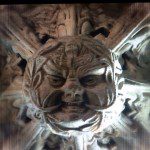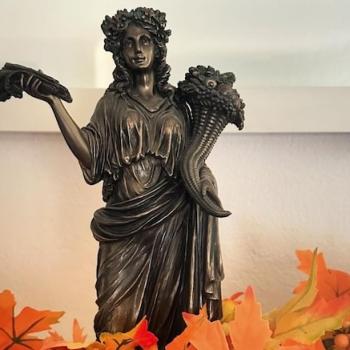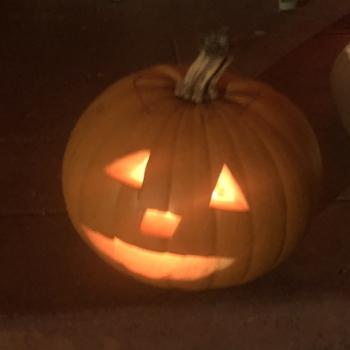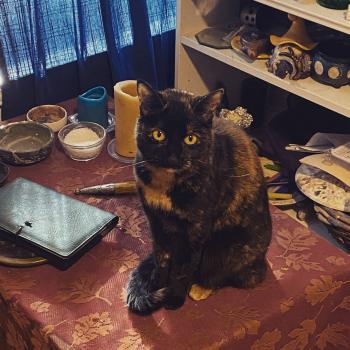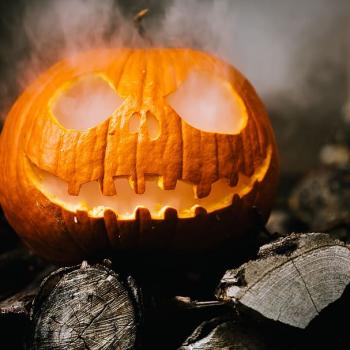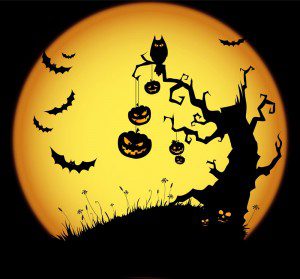 Holidays don’t show up fully formed, they are created slowly over time. The traditions we associate with our holidays are similar. It’s nice to imagine our pagan ancestors lighting Jack-o’-lanterns and bobbing for apples on Samhain but they didn’t do such things. Our modern Halloween traditions sometimes date back centuries, and sometimes only a few decades. They feel timeless even if they are relatively new.
Holidays don’t show up fully formed, they are created slowly over time. The traditions we associate with our holidays are similar. It’s nice to imagine our pagan ancestors lighting Jack-o’-lanterns and bobbing for apples on Samhain but they didn’t do such things. Our modern Halloween traditions sometimes date back centuries, and sometimes only a few decades. They feel timeless even if they are relatively new.
In many ways Halloween became a “dumping ground” for a variety of holiday traditions once associated with Christmas and the American Thanksgiving. A lot of the customs we associate with Halloween, Thanksgiving, and Christmas weren’t “slotted” into their current positions until the early Twentieth Century. It’s odd to think of “trick or treat” on Thanksgiving or dressing up in costume for Christmas but such things occurred on a regular basis until fairly recently. Like all of our major holidays Halloween is an exotic jumble of old and new ideas.
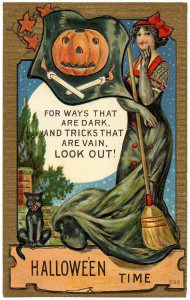 The Name Halloween The word Halloween comes from the phrases All Hallows Even and All Hallows Eve, the names given to the night before the Catholic holiday of All Saints’ Day celebrated on November 1. Like many Catholic holidays the celebration of the feast day of All Saints’ began on the evening before (think Christmas Eve). All Saints’ was followed by All Souls’ Day on the second of November. All three nights basically celebrated the dead, first the Christian saints, “all known and unknown” and then the average person. Many prayers were uttered for those poor souls stuck in purgatory, the no-man’s land between heaven and hell.
The Name Halloween The word Halloween comes from the phrases All Hallows Even and All Hallows Eve, the names given to the night before the Catholic holiday of All Saints’ Day celebrated on November 1. Like many Catholic holidays the celebration of the feast day of All Saints’ began on the evening before (think Christmas Eve). All Saints’ was followed by All Souls’ Day on the second of November. All three nights basically celebrated the dead, first the Christian saints, “all known and unknown” and then the average person. Many prayers were uttered for those poor souls stuck in purgatory, the no-man’s land between heaven and hell.
The early November holiday season also included Guy Fawkes Night on November Fifth, a night for revelry and merry making in much of England. Up until recently Guy Fawkes was the more popular holiday in many parts of the former British Empire. Guy Fawkes contains many elements we associate today with Halloween including masks, tricks, and bonfires. (Sometimes the holiday was referred to as Bonfire Night.)
Halloween has long been linked to the Celtic celebration of Samhain (which mean’s “Summer’s End), and it’s likely that the older celebration influenced the younger one to some degree. We know very little about the Celtic celebration of Samhain, but some of the things we do know seem linked to the modern Halloween. Samhain was a time of supernatural activity and people lived in fear of being snatched up by the sidh. Early chroniclers make mention of its status as a harvest celebration, but it most likely was also concerned with ancestors and the dead. Samhain also survived phonetically and in Scotland it was traditional to serve sowens, a type of porridge, on Halloween. (1) Two Roman celebrations probably had an influence on the holiday as well. The Feast of Pomona celebrated apples and seeds while Parentalia was a festival of the dead, both holidays share some similarities with our modern Halloween and even the ancient Samhain. (2)
Jack-o’-lantern The Jack-o’-lantern is perhaps the most iconic Halloween image, but oddly its history is extremely hard to trace. Most books will tell you that our modern “candle in a pumpkin” dates back to the Middle Ages when people would carve turnips and place a candle in them to represent a soul stuck in purgatory. It’s a great theory but very little documentation supports the assertion.
What’s more likely is that the modern Jack-o’-lantern evolved from a number of various sources. In Elizabethan England carnival goers used to take turns throwing objects at a “Jack-o’-Lent” (said to resemble a scarecrow) on Ash Wednesday. The use of the name “Jack” in both the lantern and the “o’Lent” is a reference to the mythical “Jack of the Tales” a trickster like figure who was deemed too wicked even for Hell. As a consolation gift the Devil threw him a lit coal which Jack collected in a hollowed out turnip. Jack was then sentenced to wander the Earth until the Christian Judgement Day, where he continued to prank unsuspecting humans.
“Jack with the lantern” eventually became Jack-o’-lantern and served as shorthand for mystical or devilish lights. Jack-o’-lanterns are often considered Scottish or Irish in origin but are most likely an American invention. Robert Burns doesn’t mention them in his poem Halloween and there’s no evidence documenting hallowed out vegetables being used as lanterns in Nineteenth Century Britain or Ireland. It’s been theorized that Irish immigrants to America were the first group to carve pumpkins on Halloween and that the tradition spread from there. By the early Twentieth Century the tradition had spread across the States and into Great Britain and has been a part of Halloween ever since. (3)
(~Update~ Shortly after posting this article the website Irish Central shared an article on a Jack-o’-lantern made from a turnip. The turnip-o’-lantern only dates from the late Nineteenth Century so it’s possible that the turnip its self was inspired by American pumpkin lanterns, or it could be actual primary evidence proving the existence of turnip and beet style lanterns. Click the link, it’s a pretty creepy picture.)
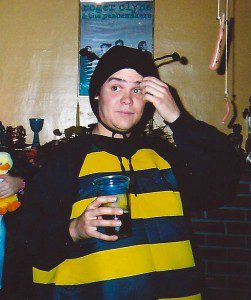 Costumes “The street was jammed with masked and costumed children making a deafening din with their penny tin horns. Some kids were too poor to buy a penny mask. They had blackened their faces with burnt cork. Other children with more prosperious parents had store costumes: sleazy Indian suits, cowboy suits and cheesecloth Dutch maiden dresses. A few indifferent ones simply draped a dirty sheet over themselves and called it a costume.” (4)
Costumes “The street was jammed with masked and costumed children making a deafening din with their penny tin horns. Some kids were too poor to buy a penny mask. They had blackened their faces with burnt cork. Other children with more prosperious parents had store costumes: sleazy Indian suits, cowboy suits and cheesecloth Dutch maiden dresses. A few indifferent ones simply draped a dirty sheet over themselves and called it a costume.” (4)
That all sounds like a traditional Halloween night but the author here is actually describing Thanksgiving in early Twentieth Century America. Up until the late 1920’s dressing up in costume and asking for treats at local businesses was a New York City Thanksgiving tradition. It only stopped when the Macy’s Thanksgiving Day Parade became too much to compete with (seriously). (5)
The tradition of wearing costumes on Halloween most likely arose from a combination of sources. Masks were a part of Guy Fawkes Day (November 5) and had long been a part of the “masquerade” tradition, a tradition stretching back centuries. People wore masks at Christmas parties and cross-dressed as well. The long “Christmas Season” in Britain (from the end of October to New Year’s) provided ample opportunity for dressing up, as did Mardi Gras celebrations. Costumes and Halloween sometimes seem like old bedfellows but the custom didn’t really catch on until the early 1900’s. When it did take off, it did so quickly, and became an integral part of the holiday.
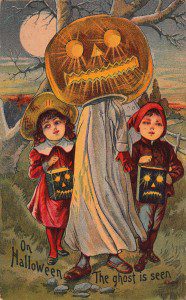 Trick or Treat “Trick or treat” sounds like a rather old greeting, but its first use in print only dates back to 1939 where it turned up in American Home magazine. The article’s writer (Doris Hudson Moss) calls the phrase an “age old salutation” but offers no historical backdrop for the claim. (It’s very likely that the phrase predates her by a few years and simply felt “old” by the time it reached her.) Much of Moss’s article is not so much about treats, but about combatting the “tricks” that were a big part of Halloween in the 1930’s. (6)
Trick or Treat “Trick or treat” sounds like a rather old greeting, but its first use in print only dates back to 1939 where it turned up in American Home magazine. The article’s writer (Doris Hudson Moss) calls the phrase an “age old salutation” but offers no historical backdrop for the claim. (It’s very likely that the phrase predates her by a few years and simply felt “old” by the time it reached her.) Much of Moss’s article is not so much about treats, but about combatting the “tricks” that were a big part of Halloween in the 1930’s. (6)
In the United States Halloween was an especially violent and costly holiday, with vandalism a high priority for many revelers. In some parts of the country schools and civic organizations organized “give aways” of candy and treats to keep young people off the streets. Such programs had varying levels of success. The most effective way to combat such shenanigans ended up being “trick or treat” and the custom took off after World War Two.
There’s a very long history of giving treats and other gifts on major holidays, going back to the Middle Ages. It was customary to expect the poor and disadvantaged to beg on such occasions, and for people to show them some charity. The Christmas tradition of wassailing can be directly linked to “trick or treat.” Asking for favors was popular in New York on Thanksgiving at the start of the last century, with much of the asking being done by children. Up until the early Twentieth Century the Scottish skeklers dressed up in animal skins and went house to house singing and begging for gifts. Similar customs exist in other parts of Europe near Christmas-time, and may be the oldest examples of “trick or treat” ever documented. (7)
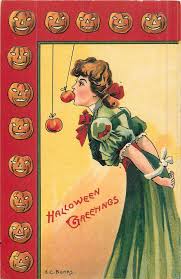 Bobbing for Apples For much of the Seventeenth and Eighteenth Centuries Halloween wasn’t associated so much with goblins and ghosts, but with divination. On Halloween young people would throw nuts into a fire, looking for a sign as to who they might later wed. The custom shows up in Robert Burns Halloween and can be found in other literary sources as well. Along with nuts apples were considered another way to tell the future.
Bobbing for Apples For much of the Seventeenth and Eighteenth Centuries Halloween wasn’t associated so much with goblins and ghosts, but with divination. On Halloween young people would throw nuts into a fire, looking for a sign as to who they might later wed. The custom shows up in Robert Burns Halloween and can be found in other literary sources as well. Along with nuts apples were considered another way to tell the future.
It was said that slicing an apple at midnight on Halloween and the eating the slices would result in the image of a future lover appearing in a mirror. Eventually apples moved away from being used in solitary pursuits and found their place in the parlor where they were bobbed for in a large bowl of water. A variation on bobbing for apples involved tying the fruit to a swinging string suspended from the ceiling. Party goers were then blindfolded and attempted to bite into the apples (most likely after being bopped in the head a few times). (8)
No matter their origins today’s Halloween traditions feel timeless and are a source of joy for hundreds of millions of Americans. After Christmas, Halloween is America’s most popular holiday. Happy Halloween!
Notes
Much of the information in this piece comes from Halloween: From Pagan Ritual to Party Night by Nicholas Rogers and Death Takes a Holiday: A Cultural History of Halloween. Halloween is meant to be the more academic text, but I got more information from Skal. I’m indebted to both authors.
1. Halloween: From Pagan Ritual to Party Night by Nicholas Rogers. Oxford University Press, 2002, page 41
2. Rogers page 11.
3. Death Takes a Holiday: A Cultural History of Halloween by David J. Skal. Bloomsbury Booms, 2002. pages 31-32
4. From the book a Tree Grows in Brooklyn by Betty Smith, a novel originally published in 1943. I came across the quote in Skal’s book, and Rogers also quotes a different part of it in his book!
5. Skal pages 44-45
6. Skal pages 52-53
7. Rogers page 41
8. Skal pages 26-28


